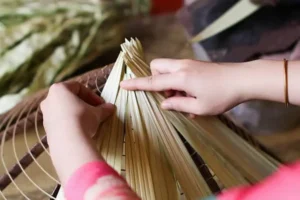Conical Hat – A Piece of Vietnam
“Non la” (translated as “conical hat”) is not only a normal hat, but also one of Vietnam’s symbols of charm. Every country has its own national headgear. The United States has the baseball cap, Britain is famous for the London bobby’s helmet. Greece is associated with the fisherman’s hat, while the beret is the symbol of France. The Israelis use the yarmulke and we usually see the Saudi Arabians in their white headdresses. Indian Sikhs wrap their heads in elaborate turbans while Russians warm their craniums with fur hats, which are of good use even at fifty Degree Celsius below zero. In Vietnam, the national chapeau is the non, or conical peasant hat. Along with the graceful silk ao dai, the non has become a sort of informal Vietnamese national symbol that is recognized worldwide.


How Inseparable It is?
The hat has a conical shape, made out of straw and is kept on the head by a silk cloth chin trap that keeps the hat from slipping out of the wearer’s head. This traditional conical hat is particularly suitable for farmers in such a tropical country as Vietnam where fierce sunshine and hard rains take place as often as girls’ sulking. It can be used as a basin or a bowl to contain water when they are thirsty, as a fan when they are hot, as a basket of a bunch of vegetables. Romantically, young couples can veil their kisses behind this traditional conical hat during their dates.
The legend behind the hat is that, once upon a time, there was a very tall woman who often wore a magical kind of hat made from four round leaves knitted together with bamboo. Wherever this woman appeared, clouds passed and the weather became favorable. After teaching people to plant vegetables and trees for their living, she secretly passed and ascended to the heavens. Yet, she was honored as the Goddess of Human and ever since, they have made hats in the shape of hers to protect themselves from the sun and the rain.
